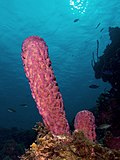Zooxanthellae (/ˌzoʊəzænˈθɛliː/; sg. zooxanthella) is a colloquial term for single-celled dinoflagellates that are able to live in symbiosis with diverse...
24 KB (2,742 words) - 03:57, 15 June 2024
polyps expel the zooxanthellae in response to stress such as high water temperature or toxins. Other corals do not rely on zooxanthellae and can live globally...
110 KB (12,238 words) - 20:18, 12 September 2024
light, or nutrients. Bleaching occurs when coral polyps expel the zooxanthellae (dinoflagellates that are commonly referred to as algae) that live inside...
138 KB (15,111 words) - 23:42, 7 August 2024
Coral reef (section Zooxanthellae)
the reef, due to what is called coral drowning. Corals that rely on zooxanthellae can die when the water becomes too deep for their symbionts to adequately...
162 KB (18,185 words) - 06:40, 7 September 2024
from a symbiotic relationship with single-celled dinoflagellates, with zooxanthellae, or with green algae, zoochlorellae, that live within the cells. Some...
43 KB (4,674 words) - 20:46, 26 August 2024
papua is one of the numerous marine animals living in symbiosis with zooxanthellae, a photosynthetic alga. Five subspecies have been described, inhabiting...
8 KB (798 words) - 21:51, 5 September 2024
as a habitat for the symbiotic single-celled dinoflagellate algae (zooxanthellae) from which the adult clams get most of their nutrition. By day, the...
29 KB (3,180 words) - 21:28, 14 August 2024
Elkhorn coral (section Zooxanthellae)
Elkhorn coral have special algae living in their tissues known as zooxanthellae. Zooxanthellae meet their nutritional requirements using photosynthesis, a process...
31 KB (3,743 words) - 11:49, 21 July 2024
"Some Spectral Characteristics of Chlorophyll c from Tridacna crocea Zooxanthellae". Biological Bulletin. 136 (1): 54–62. doi:10.2307/1539668. JSTOR 1539668...
35 KB (3,529 words) - 15:32, 25 July 2024
organisms living in symbiosis with the Red Sea coral, the protozoa and zooxanthellae, have a unique hot weather adaptation to sudden rise (and fall) in sea...
68 KB (6,832 words) - 06:24, 12 September 2024
reefs—possess polyps that are filled with symbiotic photo-synthetic zooxanthellae. While reef-forming corals are almost entirely restricted to warm and...
81 KB (8,949 words) - 08:18, 13 September 2024
reaction. The photosynthesis occurs because, like most corals, they host zooxanthellae in their tissues. The stinging cells are also found in cellular masses...
7 KB (694 words) - 18:00, 28 February 2024
provide habitat to other species, but deep-water corals do not require zooxanthellae to survive. While there are nearly as many species of deep-water corals...
30 KB (3,727 words) - 00:05, 1 August 2024
Hoegh-Guldberg, O.; McCloskey, L. R.; Muscatine, L. (April 1987). "Expulsion of zooxanthellae by symbiotic cnidarians from the Red Sea". Coral Reefs. 5 (4): 201−204...
129 KB (13,202 words) - 07:56, 25 August 2024
ISBN 978-0-19-508821-2 Toller, W.W.; Rowan, R.; Knowlton, N. (2001), "Repopulation of Zooxanthellae in the Caribbean Corals Montastraea annularis and M. faveolata following...
52 KB (5,479 words) - 09:48, 17 August 2024
reef protection Coral reef restoration Reef resilience Symbiotic algae Zooxanthellae Amphidinium Symbiodinium Other Artificial reef Aquaculture of coral...
27 KB (2,572 words) - 13:29, 21 August 2024
subspecies, it derives part of its nutrition from symbiotic algae (Zooxanthellae) that live in their tissues and part of their nutrition from captured...
4 KB (412 words) - 22:31, 19 November 2023
However, there are zooxanthellae in many non reef-forming corals; and not all hermatypic corals in shallow water contain zooxanthellae. Further, some hermatypic...
1 KB (147 words) - 01:23, 12 October 2022
in shallow water and many are reef-builders. Other species lack the zooxanthellae and, having no need for well-lit areas, typically live in deep-water...
39 KB (4,002 words) - 03:39, 15 September 2024
plants) such as dinoflagellates. Others harbour mutualistic algae (Zooxanthellae) in their tissues; the spotted jellyfish (Mastigias papua) is typical...
118 KB (12,403 words) - 01:58, 27 August 2024
dinoflagellates called zooxanthellae for nutrition. About 65 to 70 percent of a giant clam's nutrition is derived from zooxanthellae. These dinoflagellates...
11 KB (1,278 words) - 11:19, 7 April 2024
efficient digestion. Many corals and other marine invertebrates house zooxanthellae, single-celled algae, in their tissues. The host provides a protected...
27 KB (2,858 words) - 10:42, 17 August 2024
jellyfish's prosperity. These mutualistic microorganisms are also known as zooxanthellae, originating from the dinoflagellate phylum, and they commonly engage...
10 KB (1,193 words) - 10:39, 28 April 2024
unusually warm for extended periods of time, microscopic plants called zooxanthellae, which are symbiotic partners living within the coral polyp tissues...
43 KB (4,515 words) - 06:06, 12 September 2024
shallow-water corals contain symbiont unicellular organisms known as zooxanthellae within their tissues. These give their colour to the coral which thus...
35 KB (4,202 words) - 19:58, 18 August 2024
dinoflagellates (zooxanthellae) vertically (from the parent host to the offspring) via eggs, regardless of the heterogeneity of the zooxanthellae. Two dinoflagellate...
2 KB (122 words) - 20:20, 13 August 2023
nudibranch). They lack a mantle.[citation needed] Some are hosts to zooxanthellae. The exact systematics of nudibranchs are a topic of recent revision...
42 KB (4,262 words) - 19:22, 14 August 2024
via their special symbiotic relationship with algae known as zooxanthellae. The zooxanthellae live inside the tissues of the coral, and provide the coral...
12 KB (1,413 words) - 07:29, 2 September 2024
coast of North America. This cnidarian hosts endosymbiotic algae called zooxanthellae that contribute substantially to primary productivity in the intertidal...
9 KB (1,184 words) - 04:16, 2 June 2024
buoyant. The radiolarian can often contain symbiotic algae, especially zooxanthellae, which provide most of the cell's energy. Some of this organization...
28 KB (2,561 words) - 18:37, 13 September 2024



























